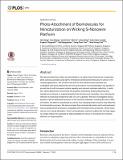| dc.contributor.author | Cheng, He | |
| dc.contributor.author | Zheng, Han | |
| dc.contributor.author | Wu, Jia Xin | |
| dc.contributor.author | Xu, Wei | |
| dc.contributor.author | Zhou, Lihan | |
| dc.contributor.author | Leong, Kam Chew | |
| dc.contributor.author | Fitzgerald, Eugene A. | |
| dc.contributor.author | Rajagopalan, Raj | |
| dc.contributor.author | Too, Heng Phon | |
| dc.contributor.author | Choi, Wee Kiong | |
| dc.date.accessioned | 2015-04-02T18:44:22Z | |
| dc.date.available | 2015-04-02T18:44:22Z | |
| dc.date.issued | 2015-02 | |
| dc.date.submitted | 2014-08 | |
| dc.identifier.issn | 1932-6203 | |
| dc.identifier.uri | http://hdl.handle.net/1721.1/96350 | |
| dc.description.abstract | We demonstrated the surface functionalization of a highly three-dimensional, superhydrophilic wicking substrate using light to immobilize functional biomolecules for sensor or microarray applications. We showed here that the three-dimensional substrate was compatible with photo-attachment and the performance of functionalization was greatly improved due to both increased surface capacity and reduced substrate reflectivity. In addition, photo-attachment circumvents the problems induced by wicking effect that was typically encountered on superhydrophilic three-dimensional substrates, thus reducing the difficulty of producing miniaturized sites on such substrate. We have investigated various aspects of photo-attachment process on the nanowire substrate, including the role of different buffers, the effect of wavelength as well as how changing probe structure may affect the functionalization process. We demonstrated that substrate fabrication and functionalization can be achieved with processes compatible with microelectronics processes, hence reducing the cost of array fabrication. Such functionalization method coupled with the high capacity surface makes the substrate an ideal candidate for sensor or microarray for sensitive detection of target analytes. | en_US |
| dc.description.sponsorship | National University of Singapore (Graduate School for Integrative Sciences and Engineering scholarship) | en_US |
| dc.description.sponsorship | GLOBALFOUNDRIES Singapore Pte. Ltd. | en_US |
| dc.description.sponsorship | Singapore-MIT Alliance | en_US |
| dc.language.iso | en_US | |
| dc.publisher | Public Library of Science | en_US |
| dc.relation.isversionof | http://dx.doi.org/10.1371/journal.pone.0116539 | en_US |
| dc.rights | Creative Commons Attribution | en_US |
| dc.rights.uri | http://creativecommons.org/licenses/by/4.0/ | en_US |
| dc.source | Public Library of Science | en_US |
| dc.title | Photo-Attachment of Biomolecules for Miniaturization on Wicking Si-Nanowire Platform | en_US |
| dc.type | Article | en_US |
| dc.identifier.citation | Cheng, He, Han Zheng, Jia Xin Wu, Wei Xu, Lihan Zhou, Kam Chew Leong, Eugene Fitzgerald, Raj Rajagopalan, Heng Phon Too, and Wee Kiong Choi. “Photo-Attachment of Biomolecules for Miniaturization on Wicking Si-Nanowire Platform.” Edited by Michiya Matsusaki. PLOS ONE 10, no. 2 (February 17, 2015): e0116539. | en_US |
| dc.contributor.department | Massachusetts Institute of Technology. Department of Electrical Engineering and Computer Science | en_US |
| dc.contributor.department | Massachusetts Institute of Technology. Department of Materials Science and Engineering | en_US |
| dc.contributor.mitauthor | Zheng, Han | en_US |
| dc.contributor.mitauthor | Xu, Wei | en_US |
| dc.contributor.mitauthor | Fitzgerald, Eugene A. | en_US |
| dc.contributor.mitauthor | Choi, Wee Kiong | en_US |
| dc.relation.journal | PLOS ONE | en_US |
| dc.eprint.version | Final published version | en_US |
| dc.type.uri | http://purl.org/eprint/type/JournalArticle | en_US |
| eprint.status | http://purl.org/eprint/status/PeerReviewed | en_US |
| dspace.orderedauthors | Cheng, He; Zheng, Han; Wu, Jia Xin; Xu, Wei; Zhou, Lihan; Leong, Kam Chew; Fitzgerald, Eugene; Rajagopalan, Raj; Too, Heng Phon; Choi, Wee Kiong | en_US |
| dc.identifier.orcid | https://orcid.org/0000-0002-1891-1959 | |
| mit.license | PUBLISHER_CC | en_US |
| mit.metadata.status | Complete | |
